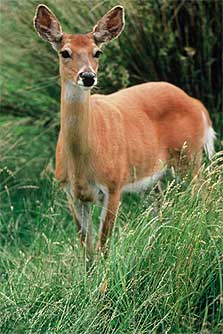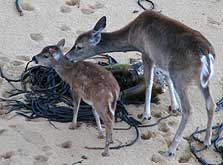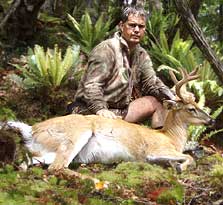
White-tail doe in summer coat
Description
Size: Males stand around 1000 mm at the shoulder and weigh 50 kg plus with females lighter at 40 kg plus.
Colour: Male and female similar in colour with winter coat grey-brown and summer a light brown. The underside, chin, upper throat, and rump patch are white. Tail long, grey brown fringed with white and white underside.
Antlers: Only male carry antlers, which curve forward with vertical tines and no brow tines. Antlers are cast July to August with new ones hardened by following March.
Social behaviour: Female white-tail deer and their offspring live in small family groups while the males live separately.
Reproduction: Females usually give birth to their first calf when two years old. Calves require milk for the first three months and stay with their mother for eight to nine months. The rut occurs late April to end of May, peaking middle May. Bucks do not call during the rut make wallows or round up females in a harem they stay with an individual doe while she is in oestrus.
Gestation period: 187 – 222 days.
Breeding: Most calves born in December- January.
Nomenclature: Male = buck. Female = doe. Young = fawn.

White-tail doe and fawn in winter coat
Where to hunt white-tail deer
You can use the hunting block search function to find hunting areas that have white-tail deer.
Search for a hunting block that has white-tail deer.
In New Zealand white-tail deer are established in two areas.
Lake Wakatipu herd
Occurring near Glenorchy at the head of Lake Wakatipu, white-tail deer occupy the lower reaches of the Rees and Dart River Valleys as well as the lower slopes of the Humboldt, Forbes and Richardson Mountains.
Habitat at low altitude is silver and red beech, Hall's totara, southern rata forest below 600 m, open tussock faces with subalpine scrub dominated by bluff systems and adjacent stretches of clear river flats containing a mixture of tussock and introduced grasses.
Hunting country at Wakatipu is a mixture of private and conservation land and hunting in this area requires a high degree of fitness.
DOC Customer Service Centre
| Phone: | 0800 275 362 |
| Email: | queenstown@doc.govt.nz |
| Address: | Whakatipu-wai-Māori / Queenstown Office |
Stewart Island herd
The white-tail deer favour the coastal areas of Stewart Island with inland use highest below 30 m elevation. Habitat is mostly dense lowland mixed podocarp – hardwood forest with few open areas. The areas of open country are mainly on the dune systems of the west coast. The topography is often confusing and hunters should be equipped with map, compass and GPS, and know how to use them.
Rakiura National Park Visitor Centre
| Phone: | +64 3 219 0009 |
| Email: | stewartisland@doc.govt.nz |
| Address: | 15 Main Road Oban 9818 |
| Hours: | Visitor centre hours and services |
Tips for hunting white-tail deer
|
Characteristic/behaviour |
Hunting response |
|---|---|
|
White-tail deer are slight and smaller than red deer. |
Calibres of .222 and above are suitable for shooting white-tail deer. |
|
White-tail deer possess well developed senses of sight, which is particularly good at detecting movement, and smell. |
Move very slowly, stopping often and hunt into the wind. Where white-tail are known to be feeding stake out rather that move through area. |
|
Tend to feed during the day in winter and early morning and evening in summer. |
Early morning and the evening tend to be the best times for hunting, whether in the bush or out in the open. |
|
During bad weather seek shelter from wind and cold. |
Hunt sunny sheltered locations. |
|
White-tail deer are creatures of habit and will often return to the same feeding spot at the same time of day. |
If you become aware of an animal visiting a location, stake out at a similar time. |
|
Once disturbed, but not shot at, white-tail will sometimes run in a complete circle back to where they started. |
Wait quietly watching from a vantage point. |
|
Much of the white-tail habitat on Stewart Island is a tangle of vegetation with thick crown fern ground cover.
|
To avoid making excess noise wear clothing that is quiet when brushed against foliage and footwear that allows for quiet movement eg lightweight rubber soled boots. |
|
White-tail deer are good swimmers and take to the water readily. |
When hunting factor in that water is no restriction to white-tail escaping or gaining access to feeding areas. |

Hunter with white-tail deer
Hunting seasons and ballots
In New Zealand there is no seasonal restriction to hunting white-tail deer meaning generally they can be hunted throughout the year. There are however instances where restrictions apply for specific reasons and periods when hunting is favoured.
Lake Wakatipu
Specific restrictions
- Hunting is available in four open blocks (Lower Dart, Upper Dart, Routeburn, Routeburn North Branch.) with no hunting within 500 m of Dart Valley Track or the Routeburn Track.
It is important to check for these conditions with the Queenstown Office queenstown@doc.govt.nz.
Favoured hunting periods
- The rut (mid April – early June) is when the bucks are occupied in attracting the attention of does and are less cautious than other times.
- Spring is another favourable time of the year to hunt white-tail deer. They come out of the forest to feed on new grass and shrub growth.
Stewart Island
Specific restrictions
- Much of the Stewart Island coastal area is managed by a booked block system that allows hunters to book 12 months in advance.
Check out availability of hunting blocks on Stewart island. - Occasionally an area may be closed on a temporary basis to enable research or other management to be undertaken without being compromised by hunting.
It is important to check for these conditions with the Stewart Island Office.
Favoured hunting periods
- The rut (mid-April – early June) is when the bucks are occupied in attracting the attention of does and are less cautious than other times.
- Spring is another favourable time of the year to hunt white-tail deer. During spring deer can be seen coming out of the forest to feed on new grass and shrub growth.
International travel with hunting trophies
You may need CITES documentation to enter or leave New Zealand with your hunting trophy.